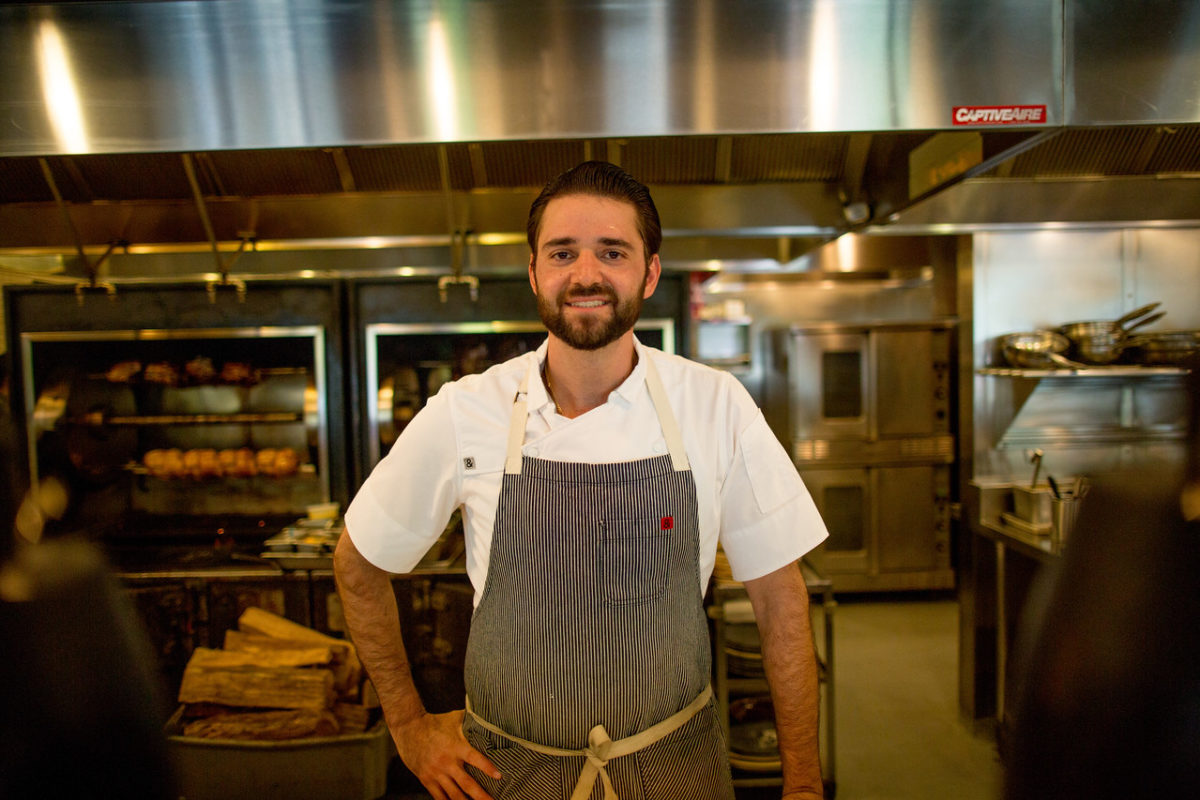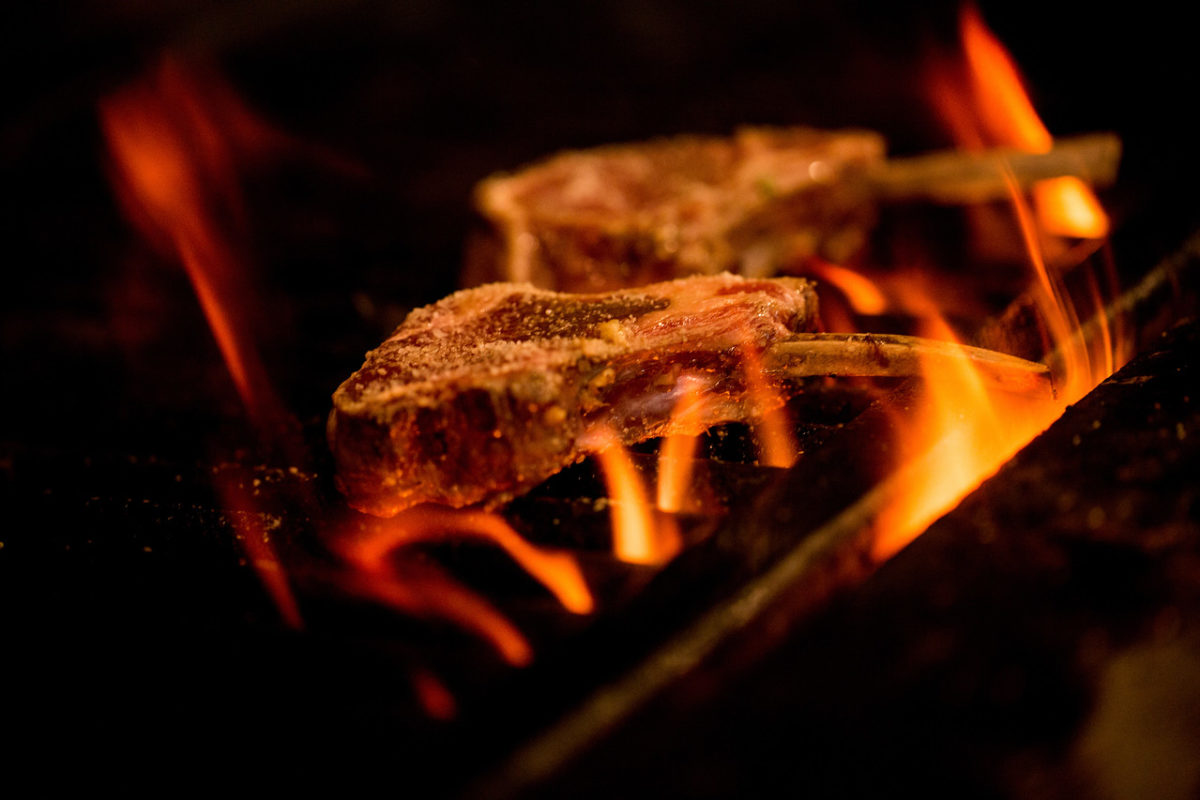Chef’s Roll has been working with True Aussie Beef & Lamb since 2015 – and we have seen and tasted, firsthand, the incredible product Australia produces — from grassfed beef to pasture-raised lamb. We’ve worked with hundreds of chefs who have also praised the product and added it to their menus. Today we’re featuring one of those chefs.
George Pagonis is executive chef and partner at Washington DC’s Kapnos, a Greek-cuisine concept that roasts whole animals daily. He’s also an ambassador for Australian lamb and beef . Here, we asked George about his story, his approach to cooking, and why he loves working with Aussie proteins.
How did you get involved in the food and beverage industry?
I was born into the restaurant business. My father is a Greek immigrant and opened a Greek Diner in Alexandria, Virginia. I worked on the weekends since I was in 2nd grade and learned every position in the kitchen. After all the years working at the diner, restaurant business was in my blood, so I decided to go to culinary school.
What makes the Washington DC food scene different from others you have been in?
What is great about DC right now is how much it is growing. Only a few years ago DC was not acknowledged as a serious food town in the United States. A lot of great chefs have moved to the area and all these great restaurants and bars have been popping up around the city in cool neighborhoods. It is nice to be a part of this culinary expansion.

Kapnos famously roasts whole animals on a daily basis. Does that present any unique challenges for an ordinary service?
Roasting whole animals is definitely a challenge especially because we use wood fire. There are a lot of variables into the process that can affect your dinner service. Timing is one, making sure you are there early enough to get the fires started and have time to allow the animal to cook. Another is controlling your fire, it can’t be super strong or you’ll dry the animal out or over-cook the exterior and not allow the inner part (inner thighs) of the animal to cook. One of the biggest challenges is to avoid flame ups. As the animal cooks, its fat begins to render and reacts with the flame. If you are not on top of it, the spit can go up in flames in a matter of seconds.
It’s obviously in your heritage, but much of your career has been built around Mediterranean, and specifically Greek cuisine. What do you think makes Greek food so special and unique?
Both my mother and father are Greek immigrants that came over to the United States. What I remember most about my childhood is going to Greece every summer. Staying in the small villages where my grandmother and grandfather are from. Far away from McDonald’s and hamburgers, we had to eat what was made for us. Greek food ties in with our culture as well, its a big part of our way of life. What I love about Greek food is the simplicity. It’s about showcasing only a few ingredients on a plate but making sure those few ingredients are some of the best and prepared well. Overall the food is generally on the healthier side, which I am a fan of.
Australia and Greece (Or Australia and DC!) could hardly be further from each other. How did you first come to start working with True Aussie Lamb and Beef?
Honestly there is a really big Greek population in Australia. Melbourne has the largest Greek population outside of Greece. But I was actually approached by True Aussie Lamb and Beef to do an event for them. After using their product and testing dishes I grew to really like the product. Our relationship grew, and I began to bring them into my other Kapnos’ in the area. I even used Aussie lamb for my James Beard dinner in NYC.

What about the Aussie products made them such a good fit for your operation?
When I was first introduced to Aussie lamb and beef, the lamb racks were the first product I used. I was very impressed with the quality of the meat. Later on, my relationship began to grow with Aussie and I started to bring in more and more products. At Kapnos we used a lot of Aussie lamb and several different cuts.
Would you recommend Aussie Lamb and Beef to other chefs?
Yes I would definitely recommend Aussie lamb to other chefs. The quality of lamb is absolutely excellent. It all starts with the animal and the environment in which the lamb is raised and what it eats. I know the farmers in Australia take great pride in how they raise their animals and it shows in the meat. It has great flavor, texture, and the color is bright red.
You’ve shared one of your favorite recipes with us here, Grilled Rack of Lamb and Spit Roasted Lamb Shoulder. Why do you love this recipe so much, and specifically, how did you approach the use of the protein featured here?
The approach of this dish is to showcase two different cuts of meat and two different cooking techniques. The rack of lamb is a naturally tender product, so the key is to marinade nicely to grill over wood fire. At Kapnos, the restaurant is built on spit roasted lamb shoulder. They are spit roasted for about 8-9 hours over a wood fire until the meat falls off the bone. It is difficult to just showcase one cut of meat and only one cooking technique.
True Aussie Featured Recipe:
GRILLED RACK OF AUSTRALIAN LAMB & SPIT ROASTED AUSTRALIAN LAMB SHOULDER
Charred eggplant purée | Ras al hanout carrots | Jus
LAMB CHOPS
INGREDIENTS
- 2 ea. Bay Leaves
- 1 ea. Rosemary
- 1 ea. Thyme
- 1 ea. Oregano
- 1 ea. Lemon, zest
- 1 up Olive oil
- 1 ea. Garlic Clove, smashed
- 1 tbsp. Black peppercorns, toasted and crushed
DIRECTIONS
- Combine all ingredients in a bowl and mix well.
- Place lamb chops in marinade, let marinate overnight.
- Wipe off marinade, season with salt, grill on both sides till medium rare.
CARROTS
INGREDIENTS
- 4 ea. Heirloom carrots
- 2 tbsp. Olive Oil
- 1 tbsp. Ras al Hanout
- 1 tbsp. Butter
- 2 cups Chicken stock
DIRECTIONS
- Peel Carrots. Heat up medium size saute pan.
- Place olive oil in pan and add carrots.
- Saute carrots with olive oil and season with salt.
- After 2 minutes add, ras al hanout spice, and saute another 3 minutes.
- Add Chicken Stock to pan then cook down the carrots until tender.
LAMB SHOULDER
INGREDIENTS
- Australian Lamb shoulder
- 2 ea.Bay Leaves
- 1 ea. Rosemary
- 1 ea. Thyme
- 1 ea. Oregano
- 1 ea. Lemon, zest
- 1 cup Olive oil
- 1 ea. Garlic Clove, smashed
- 1 tbsp. Black peppercorns, toasted and crushed
DIRECTIONS
- Mix all ingredients together and marinate Lamb Shoulder for 48 hours.
- Remove from marinade and wipe off. Season with salt and truss lamb shoulder.
- Skewer Lamb Shoulder on bar. Place bar on Spit-Roaster (if you have one) and slow roast for 8 hours over wood fire.
- Be sure to maintain fire by adding fire wood in as needed.
- When the top bone of the lamb shoulder is loose, that means its ready.
- Remove Lamb Shoulder from spit-roaster and let rest.
- Break down lamb shoulder, removing bones and cartilage. Place lamb shoulder meat into a saute pan with 2C lamb jus.
EGGPLANT PUREE
INGREDIENTS
- 2 ea. Large Eggplant
- 1 cup Tahini
- 1 cup, roasted Garlic
- 2 ea. Lemons, juice
- 1 cup H20
- 1 cup Olive oil
- 3 tbsp. Sherry Vinegar
- 2 tbsp. Honey
- 1 tbsp. Pomegranate Molasses
DIRECTIONS
- Place Eggplant on grill. Cook until eggplant is completely charred.
- Scoop out inside of eggplant and separate charred skins (but don’t throw them away).
- Place insides of eggplant in blender all the remainder of ingredients and half the amount of charred skins in blender. Blend in vita mix on high.
- Pass Puree through a chinoise and adjust seasoning with salt, sherry, lemon juice.



